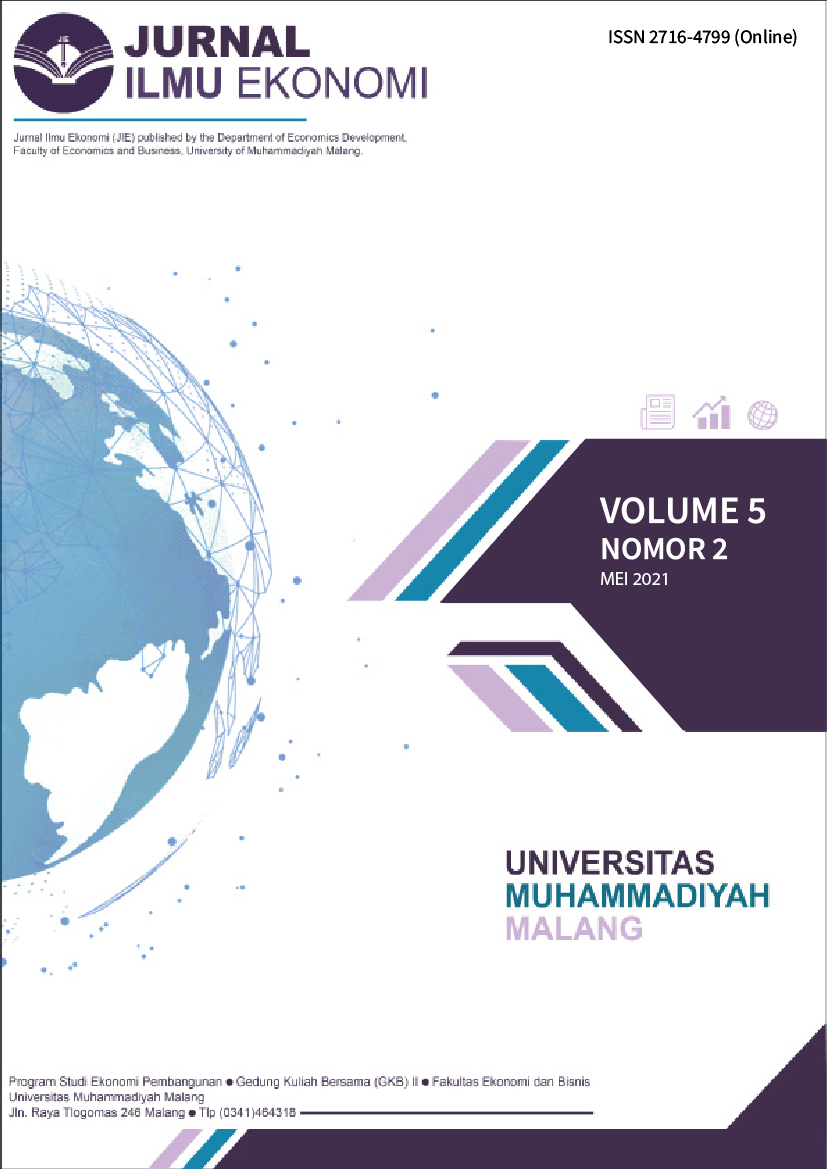ANALISIS PENGEMBANGAN SEKTOR PARIWISATA KABUPATEN SUMBAWA
DOI:
https://doi.org/10.22219/jie.v5i2.16253Abstract
By utilizing exotic resources, making tourism places as known as the tourism sector in Sumbawa Regency that plays an important role in regional economic growth in Sumbawa Regency, not only playing a role in the economy but also the tourism sector as an additional source of income, both regional income and influential. on per capita income, this study aims to determine the strategy in seeking the development of the tourism sector of Sumbawa Regency, hotel tax, restaurant tax, entertainment tax, number of tourist visits, Micro, Small and Medium Enterprises (MSMEs) and Tourism Sector Manpower as independent variables. how is the development of Sumbawa district in the tourism sector, where the tourism sector is in the form of tourism sector income (the contribution of the tourism sector) as the dependent variable with the 2015-2019 research period. The research analysis uses panel data analysis with the Fixed-Effects (FE) approach. The estimation results show that hotel taxes, the number of tourist visits, MSMEs, and workers receive H0, which has increased and has a positive and significant influence on Sumbawa Regency in the tourism sector.
Downloads
References
Ardika, I. W. (2007). Pusaka Budaya dan Pariwisata (P. Larasan).
Arraniry, F. (2018). Analisis Pengaruh Sektor Pariwisata Terhadap Pendapatan Asli Daerah di Provinsi Nusa Tenggara Barat (Tahun 2012-2016).
Boediono. (2010). Ekonomi Mikro (BPFE-UGM (Ed.); Edisi kedua).
Dinas Pemuda Olahraga dan Pariwisata Kabupaten Sumbawa, data diolah.
Gujarati, D. (2014). (2014). Basic Econometrics (McGraw-Hill (Ed.)).
Nurhayati, N., & Suhendar, D. A. (2020). Analisis Optimalisasi Penerimaan Daerah Sektor Pariwisata Dalam Meningkatkan Pendapatan Asli Daerah Kab. Kuningan. 6, 1–17.
Piore dan Sabel, P. (1984). The Secend Industrial Divide : Possibilities For Prosperity (B. Book).
Pitana, I gde, & Gayatri, P. G. (2005). Sosiologi Pariwisata (Andi).
Rahma, F. N., & Handayani, H. R. (2013). Obyek Wisata Dan Pendapatan Perkapita Terhadap Penerimaan Sektor Pariwisata Di Kabupaten Kudus. Http://Ejournal-S1.Undip.Ac.Id/Index.Php/Jme, 2(2), 1–9. https://www.neliti.com/id/publications/19638/pengaruh-jumlah-kunjungan-wisatawan-jumlah-obyek-wisata-dan-pendapatan-perkapita
Soekadijo, R. G. (2000). Anatomi Pariwisata (PT Gramedi).
Spillane, J. (2011). Ekonomi Pariwisata (Kanisius).
Unesco. (2009). Intangible Cultural Heritage.
Wibowo, H. D. (2009). Aspek Hukum Dan Kelembagaan dalam Peningkatan Efisiensi dan Efektivitas Pengelolahan Wilayah Pesisir. Jurnal Hukum.
Yoeti, O. A. (1985). Pemasaran Pariwisata : Tourism Maarketing (Angkasa).
Downloads
Published
How to Cite
Issue
Section
License
Copyright (c) 2019 Jurnal Ilmu Ekonomi JIE

This work is licensed under a Creative Commons Attribution-ShareAlike 4.0 International License.
Authors who publish with this journal agree to the following terms:
- For all articles published in the JIE (Jurnal Ilmu Ekonomi), copyright is retained by the authors. Authors give permission to the publisher to announce the work with conditions. When the manuscript is accepted for publication, the authors agree to the automatic transfer of non-exclusive publishing rights to the publisher.
- Authors retain copyright and grant the journal right of first publication with the work simultaneously licensed under a Creative Commons Attribution-NonCommercial-ShareAlike 4.0 International License that allows others to share the work with an acknowledgement of the work's authorship and initial publication in this journal.
- Authors are able to enter into separate, additional contractual arrangements for the non-exclusive distribution of the journal's published version of the work (e.g., post it to an institutional repository or publish it in a book), with an acknowledgement of its initial publication in this journal.
- Authors are permitted and encouraged to post their work online (e.g., in institutional repositories or on their website) prior to and during the submission process, as it can lead to productive exchanges, as well as earlier and greater citation of published work (See The Effect of Open Access).
This is an open access article and licensed under a Creative Commons Attribution-NonCommercial-ShareAlike 4.0 International License








